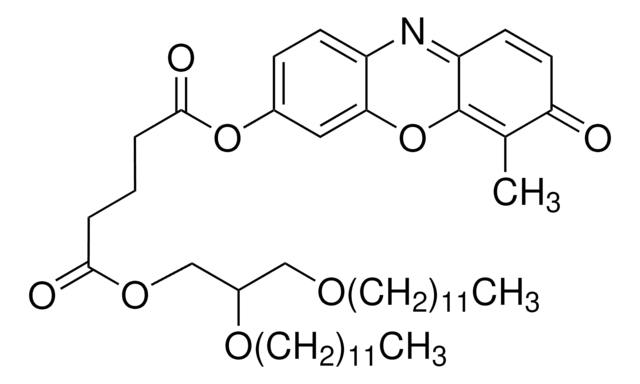If this product has an expiration or retest date, it will be shown on the Certificate of Analysis (COA, CofA). If there is no retest or expiration date listed on the product's COA, we do not have suitable stability data to determine a shelf life. For these products, the only date on the COA will be the release date; a retest, expiration, or use-by-date will not be displayed.
For all products, we recommend handling per defined conditions as printed in our product literature and website product descriptions. We recommend that products should be routinely inspected by customers to ensure they perform as expected.
For products without retest or expiration dates, our standard warranty of 1 year from the date of shipment is applicable.
For more information, please refer to the Product Dating Information document: https://www.sigmaaldrich.com/deepweb/assets/sigmaaldrich/marketing/global/documents/449/386/product-dating-information-mk.pdf
MAK046
Lipase Activity Assay Kit
sufficient for 100 colorimetric tests (with glycerol standard)
About This Item
Recommended Products
usage
sufficient for 100 colorimetric tests (with glycerol standard)
detection method
colorimetric
relevant disease(s)
pulmonary disorders; gastrointestinal diseases; cancer
storage temp.
−20°C
General description
Application
Features and Benefits
Suitability
Principle
related product
replaced by
Signal Word
Danger
Hazard Statements
Precautionary Statements
Hazard Classifications
Eye Dam. 1 - Resp. Sens. 1 - Skin Irrit. 2 - Skin Sens. 1 - STOT SE 3
Target Organs
Respiratory system
Storage Class Code
10 - Combustible liquids
Flash Point(F)
188.6 °F - closed cup
Flash Point(C)
87 °C - closed cup
Choose from one of the most recent versions:
Certificates of Analysis (COA)
Don't see the Right Version?
If you require a particular version, you can look up a specific certificate by the Lot or Batch number.
Already Own This Product?
Find documentation for the products that you have recently purchased in the Document Library.
-
How can I determine the shelf life / expiration / retest date of this product?
1 answer-
Helpful?
-
-
How is shipping temperature determined? And how is it related to the product storage temperature?
1 answer-
Products may be shipped at a different temperature than the recommended long-term storage temperature. If the product quality is sensitive to short-term exposure to conditions other than the recommended long-term storage, it will be shipped on wet or dry-ice. If the product quality is NOT affected by short-term exposure to conditions other than the recommended long-term storage, it will be shipped at ambient temperature. As shipping routes are configured for minimum transit times, shipping at ambient temperature helps control shipping costs for our customers. For more information, please refer to the Storage and Transport Conditions document: https://www.sigmaaldrich.com/deepweb/assets/sigmaaldrich/marketing/global/documents/316/622/storage-transport-conditions-mk.pdf
Helpful?
-
-
What is the LOD/LOQ for this kit?
1 answer-
This lipase assay kit detects lipase activity as low as 0.02 mU per well.
Helpful?
-
-
Are there available applications for running MAK046, MAK047, and MAK048 on Beckman chemistry analyzers like the AU5800 and AU680?
1 answer-
The MAK series of kits were not designed for use on chemistry analyzers. There are no applications available for use on chemistry analyzers from Beckman or other manufacturers. The kits, as sold, are intended for manual use. Even if the kits could be adapted to run on the chemistry analyzers, the volumes of reagents supplied are likely insufficient to perform the number of tests advertised for any particular kit.
Helpful?
-
-
It says from the manual that sample absorbance would increase overtime but may I know whether the absorbance of standards (glycerol) will increase overtime as well ?
1 answer-
The glycerol standard is essentially the end product, thus the absorbance will not continue to increase. Lipase in the sample hydrolyzes the triglyceride substrate to form glycerol, which is a process that occurs over time. For this reason, absorbance readings of the samples will continue to increase. The standard curve for this product should be read in end point mode at the end of the incubation time. See the link below to review the kit protocol. Note steps 5 & 6 detail this process.
https://www.sigmaaldrich.com/deepweb/assets/sigmaaldrich/product/documents/312/996/mak046bul.pdfHelpful?
-
-
What is the length of the acyl chain of the lipase substrate?
1 answer-
The lipase substrate included in this kit is proprietary. Further information is not available.
Helpful?
-
-
Is possible to use this kit for measuring lipase kit from milk or cheese?
1 answer-
While this kit has not been tested specifically for lipase activity in dairy products, there is no reason to suspect it would not be suitable. Note that some lipases are calcium-dependent which may be relevant to dairy samples. Please review the product information to determine the appropriate sample preparation:
https://www.sigmaaldrich.com/deepweb/assets/sigmaaldrich/product/documents/312/996/mak046bul.pdfHelpful?
-
-
What kind of material is the POSITIVE CONTROL in KIT?
1 answer-
The positive control is a CV lipase: Chromobacterium viscosum lipase.
Helpful?
-
-
Can these kits be used with serum samples from mouse?
1 answer-
Yes, this kit can be used on mouse serum samples. We generally recommend that fresh serum samples be used. Frozen samples can probably be used. However, the successful use of frozen samples depends on the efficiency of freezing them and the amount of time they have been frozen. If previously frozen serum samples are used, you may want to check the performance of the kit with fresh vs. frozen samples.
Helpful?
-
-
What is the Department of Transportation shipping information for this product?
1 answer-
Transportation information can be found in Section 14 of the product's (M)SDS.To access the shipping information for this material, use the link on the product detail page for the product.
Helpful?
-
Active Filters
Our team of scientists has experience in all areas of research including Life Science, Material Science, Chemical Synthesis, Chromatography, Analytical and many others.
Contact Technical Service









